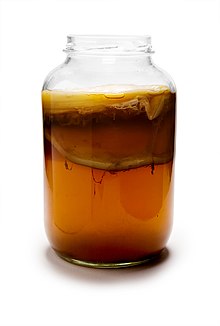콤부차

콤부차(Kombucha)는 건강 효능이 있다고 광고되는 달달하게 만든 발효 차 음료이다. 주로 홍차 베이스이며 지역 및 생산자에 따라 다양하나, 차를 발효시킨 후 가미(가당)한다는 공통점이 있다. 과즙, 향신료, 과일, 기타 착향료가 추가되기도 한다.
이 음료는 중국에서 기원한 것으로 간주되며[1][2], 용어는 일어 오전파 민간어원설이 주류로 주장된다. 20세기 초에 러시아로, 이후 동유럽 일부 지역과 독일로 퍼져나갔다.[3] 콤푸차는 현재 전 세계적으로 자가양조되며 병에 남겨 상업적으로 판매된다.[4] 전 세계 콤부차 시장의 가치는 2019년 기준으로 대략 17억 미국 달러이다.[5]
콤부차는 박테리아와 효모(SCOBY)의 공생 배양을 사용하여 달달한 차의 공생발효 과정을 통해 만들어진다. SCOBY의 미생물 개체는 다양한 편이다. 효모 성분은 보통 다른 종들과 함께 사카로미세스 세레비시아를 함유한다. 박테리아 성분은 효모가 만들어낸 알코올을 아세트산(및 기타 산)으로 산화하는 글루콘아세토박터 자일리누스(Gluconacetobacter xylinus)가 거의 무조건 함유되어 있다.[6] SCOBY가 보통 차곰팡이(tea fungus)로 불리지만 실제로는 "미생물막 내에 아세트산 박테리아와 호압 효모의 공생적 성장"을 의미한다.[4] 생종하는 박테리아는 이 음료의 인기의 이유 중 하나인 프로바이오틱으로 언급된다.[7][8]
콤부차 음용에 따른 수많은 건강상 이점이 주장되고 있으나[9] 이러한 주장들을 뒷받침할 근거는 전무한 편이다.[7][9][10] 이 음료는 집에서 만드는 동안 식중독을 일으킬 수 있는 심각한 유해효과가 드물게 발생한다.[11][12] 치료 목적으로는 권고되지 않는다.[9][13]
역사[편집]
콤부차는 중화인민공화국의 보하이해 지역에서 기원했을 가능성이 높다.[2] 이 음료는 러시아에서 소비되었으며 그곳에서 유럽의 나머지 지역으로 흘러들어갔다.[14] 이 음료의 소비는 21세기 초에 미국에서 증가하였다.[15][16] 0.5% 미만의 알콜 함량을 가진 콤부차는 미국에서 연방법에 따른 술 음료 규제를 받지 않는다.[17][18]
2015년 전까지 판매되는 일부 콤부차 브랜드들은 이 알콜 함량 기준을 넘는 경우가 있어서 새로운 시험방식의 개발이 시작되었다.[19] 21세기 초에 선진국들에서 인기가 상승하자 식당, 펍의 맥주 및 기타 술 음료의 대안으로서 광고된 이후 콤부차 판매량이 증가했다.[20]
용어의 어원[편집]
일본어로 콘부차 또는 코부차(昆布茶)는 가루 형태의 콤부(다시마)로 만들어진 다시마차를 가리키며 세계의 다른 지역의 콤부차와 보통 연관되는 발효차와는 완전히 다른 음료이다.
콤부차의 어원은 불확실하다. 그러나 일본에서 잘못 차용된 외래어일 것이라는 추측이 있다.[21] 영어 사용 화자들이 일본의 발효차가 홍차버섯(紅茶キノコ, 코차키노코)으로 불리는 사실을 볼 때 그 단어와 상기 콤부차 등을 발효차 통칭으로 오해하며 서양에 전파된 것이라는 가설이 있다.[22]
같이 보기[편집]
각주[편집]
- ↑ “kombucha | Description, History, & Nutrition”. 《Encyclopedia Britannica》 (영어). 2021년 4월 20일에 확인함.
- ↑ 가 나 Alex., LaGory (2016). 《The Big Book of Kombucha》. Storey Publishing, LLC. 251쪽. ISBN 978-1-61212-435-3. OCLC 1051088525.
- ↑ Troitino, Christina. “Kombucha 101: Demystifying The Past, Present And Future Of The Fermented Tea Drink”. 《Forbes》. 2017년 4월 10일에 확인함.
- ↑ 가 나 Jayabalan, Rasu (2014년 6월 21일). “A Review on Kombucha Tea—Microbiology, Composition, Fermentation, Beneficial Effects, Toxicity, and Tea Fungus”. 《Comprehensive Reviews in Food Science and Food Safety》 13 (4): 538–550. doi:10.1111/1541-4337.12073. PMID 33412713.
- ↑ “Kombucha Market Size, Share & Trends Analysis Report By Flavor (Original, Flavored), By Distribution Channel (Supermarkets, Health Stores, Online Stores), By Region, And Segment Forecasts, 2020 - 2027”. Grandview Research. February 2020.
- ↑ Jonas, Rainer; Farah, Luiz F. (1998). “Production and application of microbial cellulose”. 《Polymer Degradation and Stability》 59 (1–3): 101–106. doi:10.1016/s0141-3910(97)00197-3.
- ↑ 가 나 Bauer, Brent (2017년 7월 8일). “What is kombucha tea? Does it have any health benefits?”. 《Mayo Clinic》. 2018년 9월 5일에 확인함.
- ↑ Wollan, Malia (2010년 3월 24일). “Kombucha Tea Attracts a Following and Doubters”. 《The New York Times》. 2018년 9월 5일에 확인함.
- ↑ 가 나 다 Ernst E (2003). “Kombucha: a systematic review of the clinical evidence”. 《Forschende Komplementärmedizin und Klassische Naturheilkunde》 10 (2): 85–87. doi:10.1159/000071667. PMID 12808367. S2CID 42348141.
- ↑ Kapp, J. M.; Sumner, W. (2019). “Kombucha: a systematic review of the empirical evidence of human health benefit”. 《Annals of Epidemiology》 (Elsevier) 30: 66–70. doi:10.1016/j.annepidem.2018.11.001. PMID 30527803. S2CID 54472564. 2021년 8월 4일에 확인함.
- ↑ “Kombucha”. Memorial Sloan Kettering Cancer Center. 2014년 5월 22일. 2015년 6월 1일에 확인함.
- ↑ Russell J, Rovere A, 편집. (2009). 〈Kombucha Tea〉. 《American Cancer Society Complete Guide to Complementary and Alternative Cancer Therapies》 2판. American Cancer Society. 629–633쪽. ISBN 9780944235713.
Serious side effects and occasional deaths have been associated with drinking Kombucha tea
- ↑ Bauer, Brent. “What is kombucha tea? Does it have any health benefits?”. 《Mayo Clinic》. 2020년 5월 28일에 확인함.
- ↑ Sreeramulu, G; Zhu, Y; Knol, W (2000). “Kombucha fermentation and its antimicrobial activity” (PDF). 《Journal of Agricultural and Food Chemistry》 48 (6): 2589–2594. doi:10.1021/jf991333m. PMID 10888589.
It originated in northeast China (Manchuria) and later spread to Russia and the rest of the world.
- ↑ Hamblin, James (2016년 12월 8일). “Is Fermented Tea Making People Feel Enlightened Because of ... Alcohol?”. The Atlantic. 2017년 11월 26일에 확인함.
- ↑ Sandor Ellix Katz (2012). 《The Art of Fermentation: An In-depth Exploration of Essential Concepts and Processes from Around the World》. Chelsea Green Publishing. 167–쪽. ISBN 978-1-60358-286-5.
- ↑ “Hard Kombucha Is Super Trendy, but Is It Good for You? We Asked Nutritionists”. 《Health.com》.
- ↑ “Hard Kombucha Is the New Trendy Beverage You Should Try”. 《Better Homes & Gardens》.
- ↑ Wyatt, Kristen (2015년 10월 12일). “As kombucha sales boom, makers ask feds for new alcohol test”. Associated Press. 2017년 11월 26일에 확인함.
- ↑ Fleming, Amy (2018년 10월 11일). “Kombucha: can the fermented drink compete with beer at the bar?”. 《The Guardian》 (영어). 2018년 10월 11일에 확인함.
- ↑ Algeo, John; Algeo, Adele (1997). “Among the New Words”. 《American Speech》 72 (2): 183–97. doi:10.2307/455789. JSTOR 455789.
- ↑ Wong, Crystal (2007년 7월 12일). “U.S. 'kombucha': Smelly and No Kelp”. 《Japan Times》. 2015년 6월 14일에 확인함..
외부 링크[편집]
 위키미디어 공용에 콤부차 관련 미디어 분류가 있습니다.
위키미디어 공용에 콤부차 관련 미디어 분류가 있습니다.
